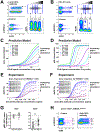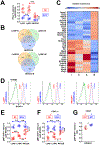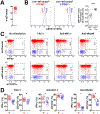Dynamic variability in SHP-1 abundance determines natural killer cell responsiveness
- PMID: 34752140
- PMCID: PMC8791782
- DOI: 10.1126/scisignal.abe5380
Dynamic variability in SHP-1 abundance determines natural killer cell responsiveness
Abstract
Interactions between human leukocyte antigen (HLA) molecules on target cells and the inhibitory killer cell immunoglobulin-like receptors (KIRs) and heterodimeric inhibitory receptor CD94-NKG2A on human natural killer (NK) cells shape and program various response capacities. A functionally orthologous system exists in mice, consisting of major histocompatibility complex (MHC) molecules on target cells and the inhibitory Ly49 and CD94-NKG2A receptors on NK cells. Here, we found that the abundance of Src homology 2 domain–containing phosphatase-1 (SHP-1) in NK cells was established by interactions between MHCs and NK cell inhibitory receptors, although phenotypically identical NK cell populations still showed substantial variability in endogenous SHP-1 abundance and NK cell response potential. Human and mouse NK cell populations with high responsiveness had low SHP-1 abundance, and a reduction in SHP-1 abundance in NK cells enhanced their responsiveness. Computational modeling of NK cell activation by membrane-proximal signaling events identified SHP-1 as a negative amplitude regulator, which was validated by single-cell analysis of human NK cell responsiveness. The amount of mRNA and protein varied among responsive NK cells despite their similar chromatin accessibility to that of unresponsive cells, suggesting dynamic regulation of SHP-1 abundance. Low intracellular SHP-1 abundance was a biomarker of responsive NK cells. Together, these data suggest that enhancing NK cell function through the acute loss of SHP-1 abundance or activity may enhance the tumoricidal capacity of NK cells.
Conflict of interest statement
Figures






Similar articles
-
Inhibition of antigen-induced T cell response and antibody-induced NK cell cytotoxicity by NKG2A: association of NKG2A with SHP-1 and SHP-2 protein-tyrosine phosphatases.Eur J Immunol. 1998 Jan;28(1):264-76. doi: 10.1002/(SICI)1521-4141(199801)28:01<264::AID-IMMU264>3.0.CO;2-O. Eur J Immunol. 1998. PMID: 9485206
-
Impaired natural killing of MHC class I-deficient targets by NK cells expressing a catalytically inactive form of SHP-1.J Immunol. 2000 Aug 1;165(3):1314-21. doi: 10.4049/jimmunol.165.3.1314. J Immunol. 2000. PMID: 10903732
-
Expression of p58.2 or CD94/NKG2A inhibitory receptors in an NK-like cell line, YTINDY, leads to HLA Class I-mediated inhibition of cytotoxicity in the p58.2- but not the CD94/NKG2A-expressing transfectant.Cell Immunol. 2002 Sep;219(1):57-70. doi: 10.1016/s0008-8749(02)00578-6. Cell Immunol. 2002. PMID: 12473268
-
Inhibition of natural killer cell activation signals by killer cell immunoglobulin-like receptors (CD158).Immunol Rev. 2001 Jun;181:223-33. doi: 10.1034/j.1600-065x.2001.1810119.x. Immunol Rev. 2001. PMID: 11513144 Review.
-
Structural basis of MHC class I recognition by natural killer cell receptors.Immunol Rev. 2001 Jun;181:52-65. doi: 10.1034/j.1600-065x.2001.1810104.x. Immunol Rev. 2001. PMID: 11513152 Review.
Cited by
-
Inhibition of SHP-1 activity by PKC-θ regulates NK cell activation threshold and cytotoxicity.Elife. 2022 Mar 8;11:e73282. doi: 10.7554/eLife.73282. Elife. 2022. PMID: 35258455 Free PMC article.
-
Liebig's law of the minimum in the TGF-β/SMAD pathway.PLoS Comput Biol. 2024 May 16;20(5):e1012072. doi: 10.1371/journal.pcbi.1012072. eCollection 2024 May. PLoS Comput Biol. 2024. PMID: 38753874 Free PMC article.
-
Uterine NK Cells Ace an "A" in Education: NKG2A Sets Up Crucial Functions at the Maternal-Fetal Interface.J Immunol. 2022 Oct 15;209(8):1421-1425. doi: 10.4049/jimmunol.2200384. J Immunol. 2022. PMID: 36192118 Free PMC article. Review.
-
Comprehensive snapshots of natural killer cells functions, signaling, molecular mechanisms and clinical utilization.Signal Transduct Target Ther. 2024 Nov 8;9(1):302. doi: 10.1038/s41392-024-02005-w. Signal Transduct Target Ther. 2024. PMID: 39511139 Free PMC article. Review.
-
KIR-based inhibitory CARs overcome CAR-NK cell trogocytosis-mediated fratricide and tumor escape.Nat Med. 2022 Oct;28(10):2133-2144. doi: 10.1038/s41591-022-02003-x. Epub 2022 Sep 29. Nat Med. 2022. PMID: 36175679 Free PMC article.
References
-
- Lanier LL, NK cell recognition. Annu Rev Immunol 23, 225–274 (2005). - PubMed
-
- Karre K, Ljunggren HG, Piontek G, Kiessling R, Selective rejection of H-2-deficient lymphoma variants suggests alternative immune defence strategy. Nature 319, 675–678 (1986). - PubMed
-
- Kim S, Poursine-Laurent J, Truscott SM, Lybarger L, Song YJ, Yang L, French AR, Sunwoo JB, Lemieux S, Hansen TH, Yokoyama WM, Licensing of natural killer cells by host major histocompatibility complex class I molecules. Nature 436, 709–713 (2005). - PubMed
-
- Brodin P, Karre K, Hoglund P, NK cell education: not an on-off switch but a tunable rheostat. Trends Immunol 30, 143–149 (2009). - PubMed
Publication types
MeSH terms
Substances
Grants and funding
LinkOut - more resources
Full Text Sources
Molecular Biology Databases
Research Materials
Miscellaneous

